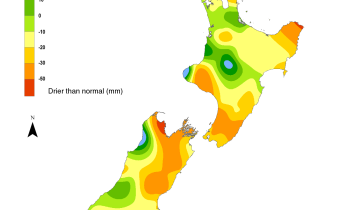Outlook: June – August 2017
June – August 2017 temperatures are about equally likely to be above average (40% or 45% chance) or near average (40% chance) for all regions of New Zealand. Above average sea surface temperatures around New Zealand and the tendency for high pressure systems to persist near the country during June and into July 2017 are likely to contribute to average or above average temperatures to start the three month period. Nevertheless, frosts and cold snaps will occur during the winter season.
June – August 2017 rainfall totals are about equally likely to be near normal (40% chance) or below normal (35% chance) in the north of the North Island and east of the South Island. For all remaining regions of New Zealand, winter rainfall totals are most likely to be near normal (40 or 45% chance). From June into July 2017, frequent high pressure systems may contribute to extended periods of dry and settled weather across much of the country, however warm Tasman Sea surface temperatures may help to energise storms as they head toward the country from time to time.
June – August 2017 soil moisture levels are equally likely to be near normal (35% chance) or above normal (35% chance) in the north of the North Island while river flows are most likely to be near normal (40% chance). In the west and east of the North Island and east of the South Island, soil moisture levels and river flows are most likely to be in the near normal range (40-45% chance). The north of the South Island is about equally likely to have near normal or above normal soil moisture levels and river flows (35-40% chance). In the west of the South Island, soil moisture levels are equally likely to be near normal (40% chance) or below normal (40% chance) and river flows are most likely to be in the near normal range (40% chance).







